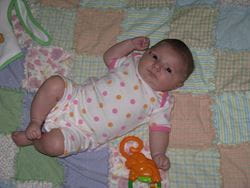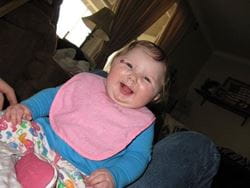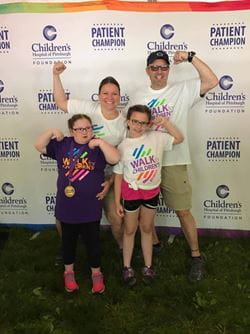When Melinda and Michael White were expecting their first child, they never anticipated any problems.
“I was expecting a healthy baby and a natural birth. I ended up having a Cesarean section and a child with a lot of special needs,” she says.
 Born at full term in DuBois, Pa., in March 2009, Megan appeared healthy. She even went directly to Melinda’s hospital room after delivery. But when she struggled to nurse, the 6-pound, 11-ounce newborn was moved to the neonatal intensive care unit (NICU) where doctors discovered she had a cleft palate.
Born at full term in DuBois, Pa., in March 2009, Megan appeared healthy. She even went directly to Melinda’s hospital room after delivery. But when she struggled to nurse, the 6-pound, 11-ounce newborn was moved to the neonatal intensive care unit (NICU) where doctors discovered she had a cleft palate.
The first diagnosis
After four days in the NICU, Melinda and Michael took Megan home to Brookville, Pa. Two days later, they drove to UPMC Children’s Hospital of Pittsburgh for an appointment with specialists at the Cleft-Craniofacial Center.
There, they met with Joseph Losee, MD, the Center’s director and chief of pediatric plastic surgery at UPMC Children’s, and Matt Ford, MS, CCC-SLP, clinical coordinator and speech pathologist. She had failed a newborn hearing test, so Megan was also seen by an audiologist and ear, nose, and throat (ENT) specialist.
Megan was quickly diagnosed with Pierre Robin sequence — a rare combination of problems that begins during development in the womb. In addition to a cleft palate, she had a smaller than normal jaw, no uvula (the fleshy ball that hangs in the back of the mouth), and her tongue fell back into her throat.
The Whites learned their daughter needed to feed using specially adapted bottles and nipples. She also had to eat in an upright position.
“It was overwhelming. I started to keep a notebook so I could keep track of everything,” says Melinda.
Ear tubes, palate surgery
After Megan’s initial appointment and testing, she went home with her parents, returning regularly for follow-up appointments with the center’s specialists.
“We saw Dr. Losee and Matt Ford at our very first appointment — and we still see them 13 years later. That continuity means a lot to us,” says Melinda. “They’ve watched Megan grow.”
 Children born with Pierre Robin sequence are prone to ear infections and hearing issues. When Megan was 6 months old, she had tubes inserted to help drain her ears — a procedure that would be repeated multiple times throughout her childhood. At 11 months, she received her first set of hearing aids that allow her to hear at normal levels.
Children born with Pierre Robin sequence are prone to ear infections and hearing issues. When Megan was 6 months old, she had tubes inserted to help drain her ears — a procedure that would be repeated multiple times throughout her childhood. At 11 months, she received her first set of hearing aids that allow her to hear at normal levels.
At 11 months, Megan also had her first palate surgery to close the roof of her mouth.
Unexpected problems
Unlike most children who undergo palate surgery, Megan’s 30-day follow-up appointment brought a big surprise: the sutures had come apart and her palate was still open. After waiting another six months for healing, Dr. Losee repeated the surgery — with the same result.
Genetic testing done after a third failed palate surgery revealed Megan had an extremely rare selenoprotein deficiency, which makes it difficult for her to heal.
“The sutures would just fall apart,” says Melinda. “Even a small scratch — that for most people would heal in three days — takes Megan 10 days to heal.”
Dr. Losee performed two more palate surgeries by the time Megan was 9 years old. To compensate for her slow healing, he used four times as many sutures and allowed additional time before removing stitches.
More complex diagnoses
When Megan was 3 years old, an MRI was done to determine why she was having trouble walking. The scan revealed more complex diagnoses for the toddler:
- Sagittal craniosynostosis — which occurs when the bones in an infant’s skull fuse prematurely.
- Tethered cord — which occurs when the spinal cord is attached to tissue around the spine.
Genetic testing also showed she had muscular dystrophy, a group of rare neuromuscular diseases caused by gene mutations that results in progressive muscle weakness and loss of muscle mass.
 Surgery to release the tethered cord — performed prior to Megan’s selenoprotein deficiency diagnosis by neurosurgeon Ian Pollack, MD, chief of pediatric neurosurgery — also failed. Dr. Pollack repeated the procedure a week later with extra precautions, including a special mesh used to close the surgery site.
Surgery to release the tethered cord — performed prior to Megan’s selenoprotein deficiency diagnosis by neurosurgeon Ian Pollack, MD, chief of pediatric neurosurgery — also failed. Dr. Pollack repeated the procedure a week later with extra precautions, including a special mesh used to close the surgery site.
Because of her slow healing and the fact that her craniosynostosis was not too severe, the Whites and Megan’s doctors agreed not to do surgery to correct the shape of her head.
“Those first few years were difficult. We kept discovering so many challenges that make Megan unique and who she is today,” says Melinda.
“Thankfully, we had Matt Ford to help guide us. He has always been so helpful and resourceful.”
Megan’s team
Although Megan hasn’t needed surgery in the past five years, she returns to UPMC Children’s regularly for follow-up appointments — a 90-minute drive from their Brookville home. Multiple appointments are scheduled for each visit to avoid the need for extra trips to Pittsburgh.
“I’m so grateful we can make the drive to Children’s and be back home in one day. We’re fortunate to have a place like that in Pittsburgh,” says Melinda.
Megan sees Dr. Losee and Matt Ford at the Cleft-Craniofacial Center once year. She also sees neurologist Hoda Abdel-Hamid, MD, once a year and endocrinologist Luigi Garibaldi, MD, twice a year.
In addition, she has appointments every six to 12 months with other pediatric specialists who work in conjunction with the Cleft-Craniofacial Center, including:
- A pulmonologist to treat severe sleep apnea related to her palate and throat issues
- A cardiologist to monitor a heart defect
- An ophthalmologist to treat a scratched cornea that hasn’t healed in over six years
- An orthodontist for dental issues related to her small jaw
- An audiologist to treat her hearing issues
“The biggest thing we’re working on now is orthodontics with Lindsay Schuster, DMD. Now that Megan has all her adult teeth and a small jaw, we’re trying to figure out the next steps without having to do surgery,” says Melinda. “Our goal is to help Megan be her best version, without the need for any surgery or invasive procedures since she doesn’t heal.”
A special child
Megan’s younger sister was born without birth defects, so she’s very aware of her differences.
“We tell her, ‘God made you special and you are perfect just the way you are,’” says Melinda.
Now a thriving 13-year-old, Megan loves to sing in the school chorus and enjoys her therapeutic dance class and playing in the Challenger softball league.
“She’s doing very well. Despite everything she’s gone through, she’s the most kind, loving, and happy girl,” says Melinda. “Everywhere we go, people know and remember Megan. She’s always excited and happy to see people.”
That includes all the doctors and specialists she sees at Children’s.
“She loves Matt and Dr. Losee. She’s excited to see them and give them a big hug,” says Melinda.
Melinda praises everyone at Children’s for the “compassionate, top-notch care” and support they’ve provided for the past 13 years.
“She’s not just a patient to them. They know Megan and they want the best for her,” says Melinda. “They will forever hold a special place in our hearts.”
Plastic Surgery Resources
Read more about plastic surgery resources from UPMC Children's Hospital Department of Plastic Surgery.









